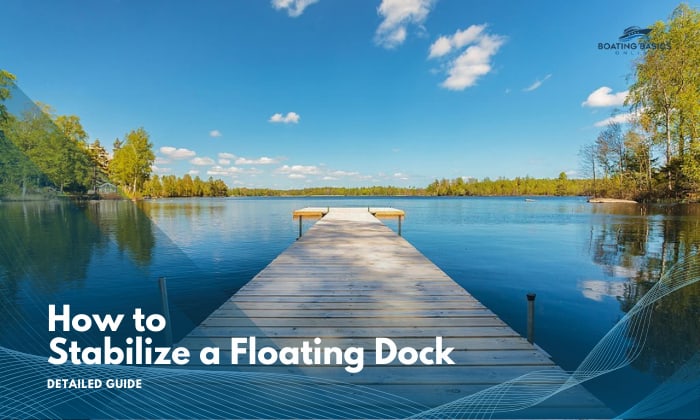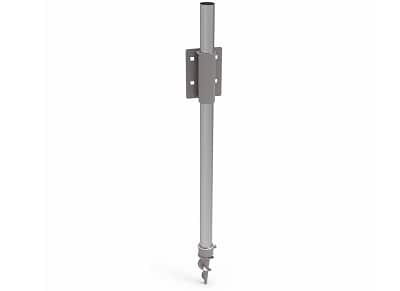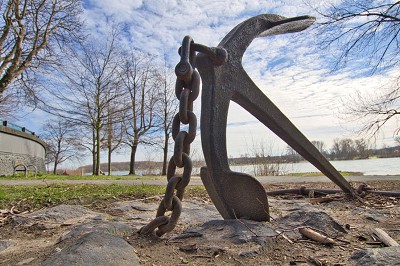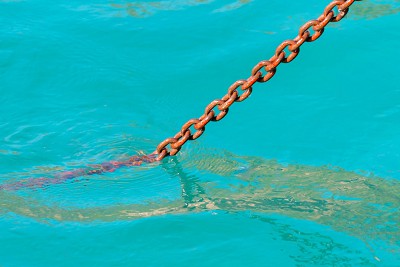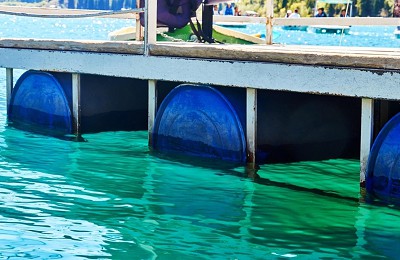Floating docks, for all their versatility and host of perks, aren’t immune to one perennial problem: stability issues. What’s good is that there’s more than one workaround for most setups and conditions.
If you want to learn how to stabilize a floating dock, this guide has your back. It will teach you a number of proven solutions that account for the main causes of dock instability such as the weather, fluctuating water conditions, dock material and configuration, among others.
Table of Contents
A Step-by-step Guide to Stabilize a Floating Dock
One of the benefits of a floating dock is that it moves with the rise and fall of the tide. That being said, when you want to make a floating dock more stable, I’m going to readily assume that you’re willing to lose some of that adaptability to water conditions.
At best, you want to keep a balance between flexibility and stability to make the most out of a floating dock.
Without further ado, here’s a list of the strategies that work.
1. Use a stabilizer kit
Your basic floating dock stabilizer kit gives you an auger and bracket combo, which should be enough to provide the support and stability it needs. Most floating dock stabilizer kits should have instructions on how to install them, particularly how long the stabilizer post needs to be.
Simply twist the auger end into the lake bottom and insert the mounting brackets into the slots on the floating dock. The brackets should be connected to the EMT tubing, and you can use a track system to add guide poles, bumpers, and other accessories to the dock.
Should you happen to not be a fan of augers, you can always opt for more permanent pilings straightaway, assuming the tide tends to fluctuate more in your area.
2. Upgrade your anchors and add more floats
Whenever people do a fresh install and anchor a floating dock on a river or lake, a few find out that they didn’t use a large enough anchor or an adequate number of floats. Sure, anchoring floating dock this way may keep it from drifting off, but the wobbling motion is palpable, if not pronounced.
This is one of the more straightforward and easy ways of securing a floating boat dock. By using a bigger anchor, you’re essentially adding more weight that, based on the laws of physics, adds more stability.
As for floats, you only need to attach floats to dock, particularly side stability floats, which will essentially increase the dock’s width and, in turn, stabilize it.
Incidentally, if you connect two floating docks together, set up anchors and chains beneath them to reduce movement.
3. Use more dock anchors and tighten anchor lines
I get that sizable anchors systems may not be able to get the job done, especially if we’re talking about locales with extra choppy waters. Fret not, you’ve still got an ace under your sleeve.
One way I’ve managed to keep motion to a minimum for a stubbornly rocky dock is by adding more dock anchors. You’ll use them to tie the dock down with chains or links of your choosing. By doing this, you get the benefit of increasing the points of anchoring, which automatically translates to more stability.
I recommend running the chains through both sides of the dock then crisscrossing them while leaving at least one to two inches of slack on the lines. You should also use quick links to connect the chains to rebars and a tension cord to minimize stress.
- Here’s another Great Tip:
You can even consider attaching the floating dock permanently to the shore while you do this. You can use standard anchors or just planks of wood or any heavy material you find suitable.
Still getting pronounced jounces? If that’s the case, tighten up those anchor lines, enough to finally take the winds and waves out of the equation.
4. Make the floats heavier
Doing this will lower the dock’s center of gravity, thus, making it stable, all while still being able to float as it should. You have two ways to approach this, and I’m going to assume you’re using those standard blue barrels that are ubiquitous in most floating dock setups.
One way to stabilize a dock in this manner is by simply filling the barrels up with a bit of water. This makes them sit lower in the water and makes your dock more stable. About a ¼ to ½ of their capacity will do. One other way is to add a ballast to the floats – about ⅓ of the way will suffice.
5. Put a roof over it
You hit two birds with one stone by doing this. After all, the roof will inevitably impart additional weight that will contribute to your present anchoring system. Moreover, everyone who uses the floating dock will be sheltered from rain and shine.
Of course, this entails additional expense, but for the double benefit alone, it’s hard to pass up.
6. Install it in a better position
For example, perhaps you’re installing a floating dock in a local pond. If so, assuming you have unlimited latitude to work with when positioning the dock, it’s always best to place it on the pond’s lee side (where the prevailing winds come from). The winds from that area tend to be weaker than your average crosswind.
7. Set up a gangway
Gangways provide access to the dock while keeping it in place. Since they often come with handrails, these structures also prevent accidents that involve people falling into the water.
Factors Affecting Floating Dock Stability
1. Artificial causes
We all know that waves always occur in most waterways. But if plenty of vessels are in your area, they will inevitably generate more waves that may rock or even damage floating docks.
The same goes for boats that are docking in them. The vessel’s weight may alter the dock’s center of gravity, causing it to become unstable.
2. Geographical and weather factors
Changing weather conditions and water depth are factors that you have no control over. If your area is prone to strong winds, big waves, and even tsunamis, then you have nothing to curse at but your luck. Still, it’s not like these problems don’t have workarounds.
3. Natural degradation
Your dock’s ballasting may migrate, which would not only decrease its buoyancy but cause it to sink as well. Steel dock components may also be susceptible to corrosion that weakens them over time.
Maintaining a Stable Floating Dock
- Regularly inspect the dock for signs of wear and tear. Promptly replace corroded cleats, bolts, and other metal parts before the problem balloons.
- Keep a close watch on water levels and adjust accordingly. This is especially true if your setup is not as adaptable to water conditions.
- Check the security of your anchor system.
- Stow away the dock, along with the floats, for the season if winters in your area are inordinately harsh.
- Do a general cleaning at least once every year.
- Consider using high-quality materials from the get-go, so you can have a dock that will last for a long time.
Safety Measures for Floating Docks
There’s no difference between fixed docks and floating docks when it comes to safety, although, of course, if your floating dock is particularly rocky, you should prioritize making it as slip-free as possible or even consider adding railings along with augers.
Besides this, here are other pointers worth remembering:
- Encourage people who frequent your dock to wear slip-resistant footwear every time they use it.
- Install bright enough lighting.
- Remove all fire hazards.
- Keep the dock clean and well-maintained.
- Refrain from using it if the weather and waves are uncooperative.
- Assuming you’ve yet to install it, plan where you’re going to position it carefully based on the insights shared here.
Conclusion
As long as you put to heart and mind all you’ve learned from this guide on how to stabilize a floating dock, you can wave goodbye to those wretched wobbles for good. Some of the solutions, like using a weightier anchor and tightening lines, work for most setups, while others are particularly beneficial if certain conditions are met.
Apply the ones that work best for you based on what’s available and your specific requirements.

“My intention from the first day establishing Boating Basics Online is to provide as much help as possible for boaters who want to experience a first safe and convenient trip. So feel free to join us and share your beautiful journeys to the sea!”

